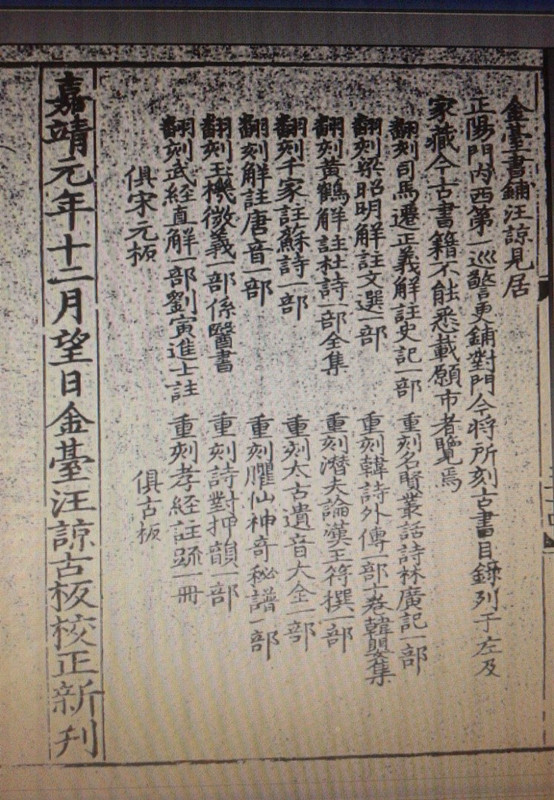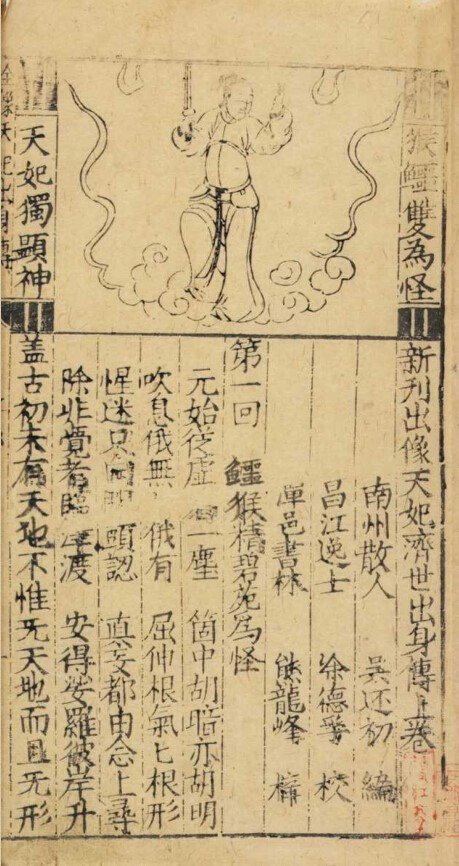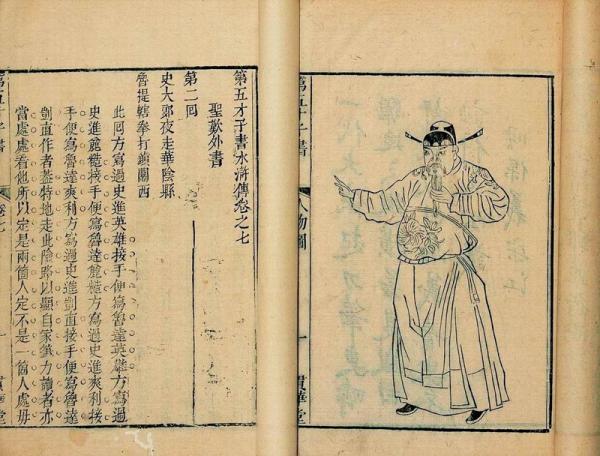How did the booksellers advertise in the Ming Dynasty: The "waist seal" has long been used.
Books are indispensable spiritual food for people. In today’s increasingly competitive publishing industry, the publication of books is always accompanied by advertising. In fact, this kind of business behavior has existed since ancient times. Then, in the Ming Dynasty, when the book industry was very prosperous, how did booksellers advertise their books? If we read a book of the Ming Dynasty, we will find that advertisements accompany the book from beginning to end.
Bibliographic advertisement
Booksellers will make an announcement before a book goes on the market, and bibliographic advertisements belong to this type. Bibliographic advertisements usually tell readers the contents of new books, the shop name, the date of engraving and other information. This advertising method existed as early as the Tang Dynasty. As for the early Ming dynasty, the form of new book preview catalogue was gradually developed.
For example, in the first year of Jiajing in the Ming Dynasty, Wang Liang, a bookseller in Beijing, published Notes on Selected Works, and he attached a list of 14 kinds of books he had "reprinted" or "re-engraved", such as Historical Records and Selected Works, to the back of this book. As the saying goes, "Wang Liang, a bookshop in Jintai, saw that the first patrol in the west, who lives in Zhengyangmen, was more shop-to-door, and now he listed the list of ancient books he had engraved on the left, and he could not know about the ancient books he Wang Liang’s other engravings also used this method. In this way, when reading this book, readers will naturally pay attention to other engraved books in this bookstore. The sales of books in the bookstore will also be improved.

List of Bibliography at the Back of Wang Liangke’s Annotation to Selected Works in Jiajing, Ming Dynasty
Title advertisement
The title of a book is the most direct window for readers to understand the content of a book. Similarly, advertising by using book names can bring readers the most direct impact. Therefore, in the small square inch of the title of the book, booksellers can say that they can do their best to tap the effectiveness of advertising. On the one hand, the bookstore writes book names in large fonts to give people a strong visual sense; On the other hand, the names of books have been modified several times.
Some booksellers will add words such as "ancient edition", "secret edition", "official edition" and "Beijing edition" before the title in order to show that the edition of their printed books is special. Most of the titles named "Jing Ben" in Ming Dynasty were published and engraved by Jianyang, Fujian, such as Yu Xiangdou’s supplement and correction of Jing Ben’s biography of loyalty and loyalty to the water margin, Xiong Qingbo’s complete biography of the Three Kingdoms, and Yang Xianchun’s biography of Jing Ben’s popular romance as a mirror, etc. "Jing Ben" refers to the book published in Beijing and Nanjing at that time. Then, why does Fujian Bookstore like to use "Jingben" as the title of the book? Regarding this question, Mr. Hu Shiying explained: "Marking the word’ Jing Ben’ was entrusted by the real calligrapher to show the reliability of the version, just as the speaker of the Song Dynasty of Judah called for’ Jingshi Laolang’, which was the usual skill of the calligraphers of Fujian Jian ‘an generation at that time." As a national publishing center, Nanjing’s printed books are superior to Fujian’s in both paper and style. Therefore, selling books in the name of "Kyoto" has become a common trick of many Fujian booksellers.
In addition to using the name "Jing Ben", the bookstore will also add the words "new edition", "new edition", "new edition", "new edition", "new edition" and "refined edition" before the title to explain the printing time and content quality, so as to attract readers who are pursuing novel content and exquisite editing. For example, the popular romance of the twenty-four emperors, which was published by Yu Xiangdou in Wanli, borrowed this technique.
In addition, adding the words "Holographic (Phase)", "Xiu Xiang (Phase)" and "Image (Phase)" before the title of the book means that there are illustrations in the book. The combination of text and pictures is pleasing to the eye, and consumers are happy to buy it. The so-called "image" refers to the form of the picture on the page of a book. "Holography" refers to the pictures in the book that reflect the content of each story. This kind of printing and engraving form has already appeared in the Yuan Dynasty. And "Xiu Xiang" is a portrait of a person attached to a book. This kind of portrait is generally sketched with lines, and the drawing is relatively fine. Adding pictures to books is more attractive than ordinary pure text books, and this method is therefore favored by booksellers.

Xiong Longfeng’s Zhong Zhengtang Edition in Wanli of Ming Dynasty "Newly Published Biography of Tian Fei’s Saving the World"
Shiyu advertisement
Knowing language is a specific style of novels in Ming and Qing Dynasties. Most of the words are located on the cover or title page of the novel, and the length is short, and the longest is only a hundred words, which is used to summarize the creation origin, theme, version, printing characteristics and other information of the novel. It is a pity that it is not used for advertising because of its eye-catching position in books. This is probably equivalent to today’s waist seal.
In the thirty-fourth year of Wanli, Yu Xiangdou published the Biography of the Countries, and its cognitive language said: "The book" Countries "was compiled by Yu Shaoyu, an ancient uncle. However, once the board is paid and reprinted several times, its board is old. The elephant bucket is corrected, re-engraved, and the whole image is broken, so that the gentlemen at home can see it at a glance. Buyers must recognize Shuangfengtang as a record. " Yu Xiangdou explained that the reason for the publication and engraving of books was that "its edition was old", and his own edition was "completely rejected", which was superior to other editions, making readers have their own comparison, and emphasized that readers should look for the logo of "Shuangfengtang" when buying. It can be seen that the booksellers in the Ming Dynasty were trying to protect and publicize their own brands while advertising hard.
Furthermore, in the early days of the apocalypse, Tianxuzhai published an ancient and modern novel edited by Feng Menglong, whose cover "knows the language" says: "Novels such as The History of the Three Kingdoms and The Water Margin are called great views. There is a person who is full of jokes and jokes. Zaju is a legend and cannot be neglected. Ben Zhai bought 120 kinds of ancient and modern celebrity romances, starting with one third. " This proverb first affirmed the value of such long works as The History of the Three Kingdoms and The Water Margin, and then put forward that short stories should be "full of fun and laughter" and "not neglected", and then drew readers’ attention to the publication of other novels in a preview tone.
Preface advertisement
Preface, also known as "preface" or "introduction", is an article written in front of a book. The preface is either self-preface or other-preface, and the content mostly explains the writing background, the origin of publication, the value of books and so on. Preface can be said to be the endorsement of the literary concept of book authors and publishers. Compared with knowing words, preface is not limited by the number of words, which can fully publicize the goodness of books and provide reference for readers to buy.
Ming people like preface, and the bookstore also intends to use preface to expand the influence of books. Written by Zhan Huai in Ming Dynasty, revised by Chen Renxi, and published in Chongzhen period, the twenty-two volumes of "A Summary of the Title of Sexual Nature" are preceded by Zhu Conggu’s saying: "Therefore, Chen Taishi’s editing is like" Compendium ",where there are those who are concerned with the treatment of body and mind, those who are concerned with the topic of the table, and those who are concerned with the joints. People are slightly detailed, people are not self-centered, well-organized, and notes are all available. Compared with other engravings, it is also the most important thing! Because I asked Si to compile it, I tried to live in catalpa to spread it widely. " This book is a book for imperial examinations, and Zhu Conggu praised this book for its detail, completeness and precision, which is "the most important one". Candidates will inevitably be moved when they see it.
Another example is Jin Shengtan’s preface to The Water Margin: "I first saw the Lotus Sutra, followed by Qu Zi’s Lisao, followed by Taishigong’s Historical Records, followed by the popular version of The Water Margin, which was the creation of an eleven-year-old illness. "Li Sao" is full of bitter words, but it is not very good. Just remember one or two sentences and sing. There are many explanations in Hokkekyo and Historical Records, but they can’t be read without courage. There is no morning, no night, no arms, and I am in the Water Margin. ….. Fu Gu thought that "The Water Margin" was precise and strict, and reading it would be the method of reading all books. You are really good at this method, and when you finish your studies next year, you will read all the books in the world with it. If it is easy to break the bamboo, my husband will sigh that Shi Naian’s "Water Margin" is really the general support of the article. " Jin Shengtan commented on the novel as a reader, combined with his reading experience, and compared it with famous books such as Li Sao and Historical Records, praising Water Margin as "the method of reading all books". There are celebrities like Jin Shengtan who "speak for" books. Based on trust and worship, readers are more willing to pay for them.

The inside page of Water Margin, a gifted scholar book appraised by Jin Shengtan.
Shuba advertisement
If there is a preface advertisement, there will naturally be a book postscript advertisement. In the Qing Dynasty, Duan Yucai’s "Explaining Words and Annotating Feet" said: "The subject is marked before it, and the postscript is followed." Postscript is the words, contents or comments on books, or textual research versions, or anecdotes written at the back of books. Advertising on the book postscript can also make readers know the printing characteristics and content quality of the book when reading the postscript.
Mao Jin of Jiguge is one of the representatives who make good use of books and postscript advertisements. The postscript to Meng Xiangyang Collection in the Book Postscript of Jiguge says: "Up to now, twelve Tang poems and Wang Meng have been engraved together, or one volume, two volumes, or four volumes, and the number of times is too few, and the original edition is confusing. It is noted that in accordance with the Song Dynasty, it was engraved with the Yuan version and the Guanzhong version, accompanied by a collection, and a total of 266 songs were obtained. If there are different words and sentences that fall down one after another, they will be divided into yuan and today, and they dare not change their minds. " Mao Jin first talked about the inferiority of other engravings, and then talked about the fineness of his own engravings and the fineness of collation. Compared with the two, readers naturally chose the best one.
In addition to the above-mentioned advertising methods, the advertising forms adopted by the book shops in the Ming Dynasty include card-writing advertisements, title page advertisements, problem-solving advertisements, generic advertisements and so on. From these advertising methods, we can get a glimpse of the publishing culture of the Ming Dynasty, and we can also appreciate the wisdom of our ancestors.
references
1. Cheng Guofu: "On the Advertising Means of Fangkan Novels in Ming Dynasty", published in Academic Research, No.6, 2007.
2. Ge Tao and Li Yanqin: "A Probe into the Marketing Art of Ancient Book Advertising", published in Wide Angle of Publishing, No.2, 2012.
3. Hu Shiying: An Introduction to the Story-based Novels, Commercial Press, September 2011.
4. Wang Haigang: A Brief Introduction to Book Advertising in Ming Dynasty, published by China Publishing, No.8, 2008.
5. Zhang Xiumin: The Printing History of China, Zhejiang Ancient Books Publishing House, October 2006.